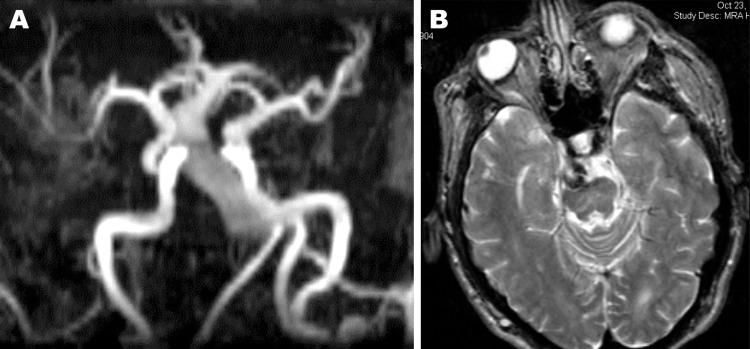Abstract
Fabry’s disease is a rare, X linked recessive disease affecting 1 in 40 000 persons. The symptoms result from a lack of or a non-functioning enzyme α galactosidase, which leads to globotriaosylceramide accumulation in the walls of blood vessels. Mortality is generally from cardiac or renal complications and death from subarachnoid haemorrhage is distinctly rare. The authors report a man with Fabry’s disease who died after subarachnoid haemorrhage from a progressively enlarging fusiform basilar aneurysm.
Background
This case illustrates a rare cause of death in a patient with Fabry’s disease and is only the second one reported in literature with the first one described in the 1970s.1
Case presentation
This patient presented with headaches in March of 2005. The medical history was significant for Fabry’s disease and was post two renal transplants. Previous MRIs showed an enlarged basilar artery. At the time, diffusion weighted images demonstrated no evidence for an infarct. Noted were significant but stable ischaemic changes in the basal ganglia, thalami and cerebellum (figure 1).
Figure 1.

Fusiform basilar aneurysm on MRA (A) and T2-weighted axial MRI (B).
In April 2006, a repeat MRI of the brain showed progressive enlargement of the fusiform basilar aneurysm (figure 2). The vertebral, internal carotid, and other major arteries of the brain had normal flow. In September of 2006, the patient presented to the emergency room with altered mental status and coded upon arrival. A CT scan revealed a massive subarachnoid haemorrhage. The patient was maintained on ventilator and pressor support until life support was later withdrawn.
Figure 2.

Increased girth of fusiform aneurysm on MRA (A) and on T2-weighted MRI (B).
Investigations
MRI scans as mentioned above.
Outcome and follow-up
The patient expired after the subarachnoid haemorrhage.
Discussion
Fabry’s disease is a rare, X linked recessive disease affecting 1 in 40 000 people. Symptoms result from a lack of or a non-functioning enzyme α galactosidase, which results in excess globotriaosylceramide (Gb3) accumulating in the walls of various blood vessels. Typical clinical symptoms include angiokeratomas, renal insufficiency and failure, cardiac problems and to a lesser extent cerebrovascular complications. Cerebrovascular symptoms typically present between age 30 and 45.2
For the majority of patients with Fabry’s disease, renal complications are the cause of death.3 By the age of 35, approximately 50% of patients with Fabry’s disease exhibit renal complications. The percentage increases to almost 100 in patients who survive till 55 years of age.4 Polyuria, polydipsia, renal insufficiency, proteinuria, renal sinus cysts, global glomerulosclerosis and tubulointerstitial fibrosis can all occur, ultimately requiring transplantation.
Cerebrovascular manifestations are much rarer in Fabry’s disease. Mitsias and Levine published a meta-analysis of the occurrence and trends of cerebrovascular complications in 53 patients with Fabry’s disease. The most common type of cerebrovascular complication was vertebrobasilar ischaemia. In addition, they noted three cases of intracranial haemorrhage; two intracerebral and one subdural.5 There were no cases of subarachnoid haemorrhage. Makos et al reported a possible link between α-glucosidase deficiency and the development of basilar artery aneurysms in three patients. A fatal rupture developed in two of the three and infarction in the third.6 We believe that because of the two renal transplants, our patient was able to live long enough to develop a progressive enlargement of the aneurysm with resultant fatal subarachnoid hemorrhage. This case illustrates a rare cause of death in a patient with Fabry’s disease.
Learning points.
-
▶
Cerebrovascular manifestations are rare in Fabry’s disease.
-
▶
The most common type of cerebrovascular complication is vertebrobasilar ischaemia.
-
▶
Aneurysmal subarachnoid haemorrhage is an extremely rare cause of death in patients with Fabry’s disease.
Footnotes
Competing interests None.
Patient consent Not obtained.
References
- 1.Maisey DN, Cosh JA. Basilar artery aneurysm and Anderson-Fabry disease. J Neurol Neurosurg Psychiatr 1980;43:85–7. [DOI] [PMC free article] [PubMed] [Google Scholar]
- 2.Brass LM, Alberts MJ. Genetic epidemiology and family studies of stroke. In: Albert MD, ed. Genetics of Cerebrovascular Disease. Armonk, New York: Futura Publishing Company; 1999:175. [Google Scholar]
- 3.Andrews PI, Ryan MM, Kandt RS. Genetic Causes of Pediatric Stroke. In: Albert MD, ed. Genetics of Cerebrovascular Disease. Armonk, New York: Futura Publishing Company; 1999:271. [Google Scholar]
- 4.Branton MH, Schiffmann R, Sabnis SG, et al. Natural history of Fabry renal disease: influence of alpha-galactosidase A activity and genetic mutations on clinical course. Medicine (Baltimore) 2002;81:122–38. [DOI] [PubMed] [Google Scholar]
- 5.Mitsias P, Levine SR. Cerebrovascular complications of Fabry’s disease. Ann Neurol 1996;40:8–17. [DOI] [PubMed] [Google Scholar]
- 6.Makos MM, McComb RD, Hart MN, et al. Alpha-glucosidase deficiency and basilar artery aneurysm: report of a sibship. Ann Neurol 1987;22:629–33. [DOI] [PubMed] [Google Scholar]


